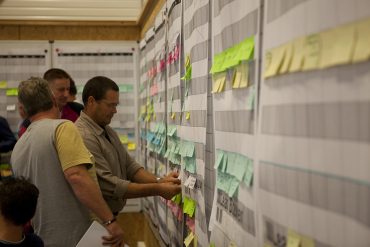
John Bleasby
Digging into construction productivity issues (Part Two)
Canadian ContractorOff- site production processes are the second half of overall productivity gains, says McKinsey
Not every builder can adopt production-line type efficiencies into their operation, but the recent McKinsey Global Institute report on construction industry productivity suggests off-site methodologies can produce equally important improvements.
Here’s a checklist almost every contractor can consider
1. Improved procurement and supply-chain management
Communication and transparency are key to streamlining the supply of labour and materials. After all, the supplier is not as sensitive to a delay in delivery of either skilled services or materials as a contractor trying to his project moving forward uninterrupted. And there are issues related to pricing too. Sure, custom home building and renovation is a bespoke undertaking, with each project offering unique challenges and requirements. However, is there an opportunity for supply pricing contracts to be based on annual purchases rather than project-by-project? Just-in-time material delivery has advantages in terms of reducing capital investment (as long as availability is assured) but is there a commercial argument to be made for purchasing and stocking quantities of standard materials at improved pricing?
2. Cloud-based technology for planning and client interaction
A wide range of planning and communication software tools are available today that allow communications to be immediate, concise and clear, not only between contractors and suppliers, but with outside trades. Some contractors might also find it advantageous to use software that permits quick communication with the client for updates, specification requests (even a simple choice of faucets), or to seek approved charge orders.
3. Making your plans and making them clear
McKinsey speaks of four levels of planning that contractors should consider, each with their purpose. First is the Master Plan. It might be very long, but it is a critical document for both the contractor and the client. It focuses on key facts and milestones outlined before work begins, leaving the details to the other plans that follow.

A Six-Week Plan accessible to the entire team allows quick visual updates regarding future requirements on site
The Pull Plan is described by McKinsey like this: “A visual tool used to plan the activities from the key milestones in the master plan. The tool is populated by working back from the final milestone on the project, detailing the key activities that need to be completed by discipline to show which player is responsible for them, what resources and suppliers are required, and the key interfaces.” This is where communications with those key sub-trades and key custom suppliers who require longer lead times are important.
The Six-Week Plan looks ahead to delivery schedules, trades schedules and milestones that allow one process to follow the next. This plan means all parties know what equipment, resources, and materials are required within a tolerance of a few days. Meeting weekly to review and move forward this six-week plan keeps it relevant and accurate.
Finally, the Daily Plan uses those elements of the Six-Week plan to ensure the right skills are doing what is needed in order to move to the next day on that plan.
4. Time dealing with waste is wasted time
Although the subject of waste refers back somewhat to on-site efficiency improvements and the increased use of modular construction processes, there needs to be a waste collection and disposal plan in place as part of the planning process. Using highly skilled and highly paid trim carpenters to sweep, collect and remove waste construction material, for example, is a poor allocation of labor.

McKinsey suggests that apprentices working under the watchful eyes of experienced trades is not the best use of skilled labour
5. Using your workforce to best advantage
Studies cited by McKinsey suggest that using experienced workers to train the less experienced through observation is inefficient. “The less experienced worker can spend up to 80 per cent of the working day observing and adding no tangible value. Instead, less experienced workers could be assigned the basic elements of a task, leaving the more complex finishing elements to the experienced worker and reducing idle time.” McKinsey claims some experts cite a 30 to 40 per cent improvement in efficiency with that modification of process.
6. Listen to your team members
Any tradesperson worth his/her salt has an inherent desire to do their job better and more efficiently. It may seem simplistic, but listening to your team members, and using technology to communicate back and forth with specialty teams, will help develop improved processes. McKinsey puts it this way: “Firms need to create a culture in which on-site knowledge sharing is encouraged and rewarded. Small individual efficiency improvements communicated to other workers can add up to large improvements across a project.” McKinsey even suggests a ‘gamified’ atmosphere with friendly competition between teams, knowledge capsules, and video clips as a way to share ideas and information within the company.
In the final analysis, home construction and renovation presents challenges not seen by other industries, which can muddy the waters when it comes to productivity improvements in comparison with assembly line industries. Weather, geography, the custom nature of the work itself, the creation of new workspaces with each project; these factors and more present a challenge to change. Doing things the way they’ve always been done before is a fallback, but is at least one constant in a world where almost every project is different with each undertaking. However, the company that improves and update their systems, their skills, and open its mind to new ideas in materials and components, will likely grow faster, improve profits, and offer employees longer and more satisfying careers as a result.
Did you miss Part One of this series? CLICK HERE
Follow John on Instagram and on Twitter for notifications about our newest posts



Leave a Reply